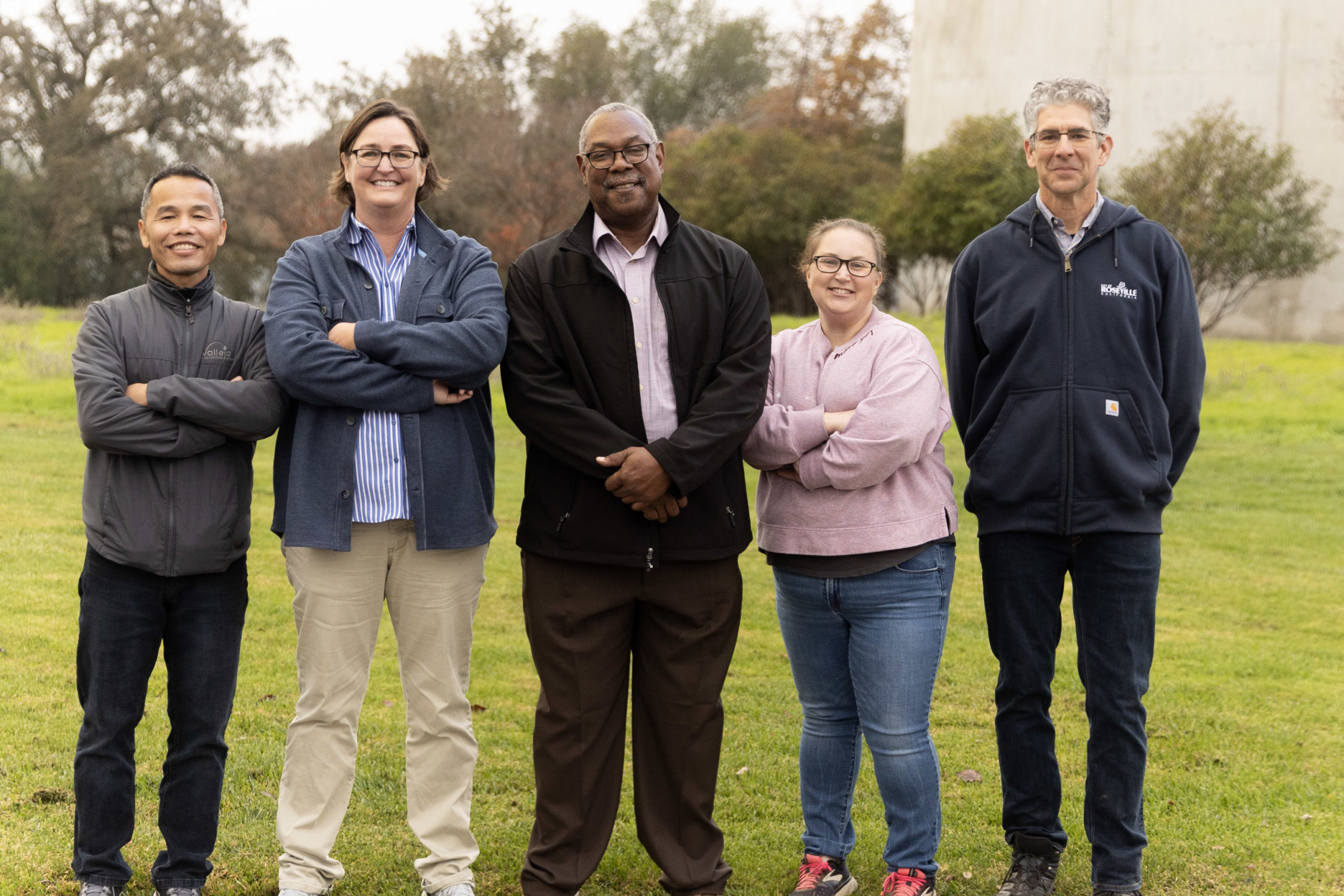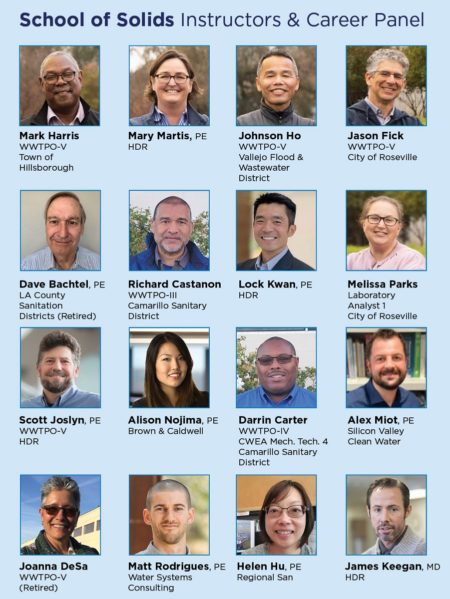
Left to right: Johnson Ho, Vallejo Flood and Wastewater District; Mary Martis, HDR; Mark Harris, Town of Hillsborough; Melissa Parks, City of Roseville; and Jason Fick, City of Roseville.
Tuesday, April 12th Workshop (fee), 9:00 a.m. – 4:00 p.m.
Download the promo flyer (pdf) >
Class details and registration info >
 The School of Solids (S.O.S.) will be an immersive, hands-on type of learning experience – one led by seasoned operators from across California (350+ years of combined experience). A full day adventure at the City of Roseville’s Dry Creek Wastewater Treatment Plant is planned with “education stations” at each unit operation along the solids treatment train.
The School of Solids (S.O.S.) will be an immersive, hands-on type of learning experience – one led by seasoned operators from across California (350+ years of combined experience). A full day adventure at the City of Roseville’s Dry Creek Wastewater Treatment Plant is planned with “education stations” at each unit operation along the solids treatment train.
What You Will Learn
We’ll have a general discussion about available technologies and then turn our attention to the installed equipment, process optimization, in-field test methods to gage performance, rules of thumb, and known maintenance “hot spots.”
Come with both your learning and teaching hats on – we promise a relaxed, interactive environment where conversation and questions will be encouraged and rewarded (that’s right…a free S.O.S. t-shirt!).
The day will end with our seasoned professionals on a panel talking about how they got where they are and how they can help you get to where you want to be.
What started as a tour of an award-winning wastewater treatment plant during the upcoming CWEA Annual Conference has also expanded to include an opportunity for conference attendees to learn from seasoned professionals during a panel discussion on entering and advancing in the industry.
The all-day tour at Roseville’s Dry Creek Wastewater Treatment Plant and after-tour panel back at the conference site will take place on April 12.
The Dry Creek plant is just one of two facilities that Roseville operates. Dry Creek is an activated sludge, tertiary, UV disinfection, Title 22 recycled water plant with an average daily flow of 18 million gallons per day with a peak flow of 42 mgd.
“We’ll tour the plant, but then we’ll focus on biosolids,” said tour organizer Mary Martis of HDR Inc. and lead for CWEA’s Biosolids Committee. “At which point we’ll send participants off to stations for hands-on troubleshooting, sharing tips and tricks and antidotes.”
For Jason Fick, Chief Plant Operator at Dry Creek, this will be a chance to show off the award-winning facility but also give participants a chance to go deeper into the biosolids process. The biosolids area will be divided into nine separate stations that will incorporate some of the main methods of processing biosolids. The station topics will cover everything from thickening and co-digestion to biogas management and cogeneration.
“I want this part of the tour to be interactive, so the training is just a start,” Fick said. “Then we can get into deeper conversations so that by the end of the day, everyone is comfortable with the people who are giving the presentations, and they can start asking questions.”
At first glance, this type of tour is geared toward operation and maintenance professionals. Still, Fick and the program hosts view the tour as a learning experience for those interested in changing roles in their current position or those interested in understanding how different facilities process their biosolids.
“This will be more than just being at a classroom at a conference, which can usually be kind of intimidating. I really want to make this accessible the whole day to everyone,” he said.
One of the program organizers, Mark Harris, will be leading the topic of thickening during the tour station discussions. Harris is currently working for the Town of Hillsborough as Manager/Superintendent of the wastewater plant. He has 32 years of experience in the field, beginning his career for the City of San Francisco and working in Pacifica along the way. As with all those hosting stations during the Dry Creek tour, Harris has deep knowledge of all aspects of biosolids treatment.
“There are a lot of conversation pieces at this station,” Harris said, naming several discussion items that would be of interest to those attending the tour. He plans to include jar testing, standard practices for blending products, tying thickening to the belt press, and best practices in optimizing, to name a few.
“I’ll also provide some antidotal and helpful information that comes from the experience of working in this industry for a long time,” he said.
Once the tour is complete and participants are returned to the conference grounds, attendees are invited to a panel discussion with members of the tour team that will focus on career advancement and getting started in the industry.
Panelist Darrin Carter is Water Reclamation Superintendent for the Camarillo Sanitary District. He has worked with many individuals interested in the field from an operating standpoint.
“There is so much that can be discussed on a panel level: from studying and taking exams, resources, training guides and especially once individuals get on a career path and taking on higher levels,” Carter said.
Martis said that the group is working on displaying potential jobs in the field and finding sponsors for scholarships.
“There are hundred-plus careers and focuses in the O&M field,” she said.
The team hopes that the panel discussion will be “pretty fluid,” said panelist Joanna De Sa, a Senior Technical Analyst for plant operations at CTS International Corporation. They plan to leave a couple of seats open for audience members who want to join in after the tour.
“One of the things I’ve always found interesting,” De Sa said, “is people don’t typically choose this business. The story is how people get here.”